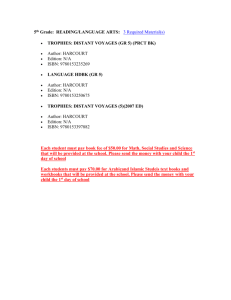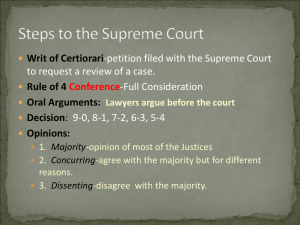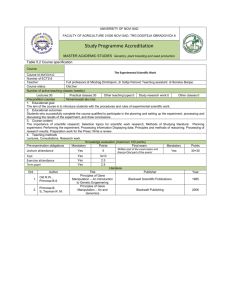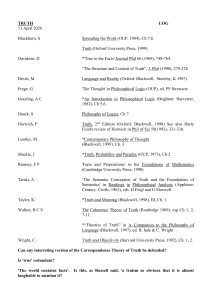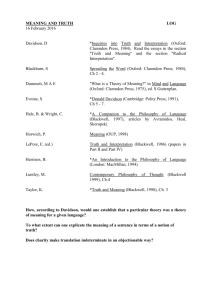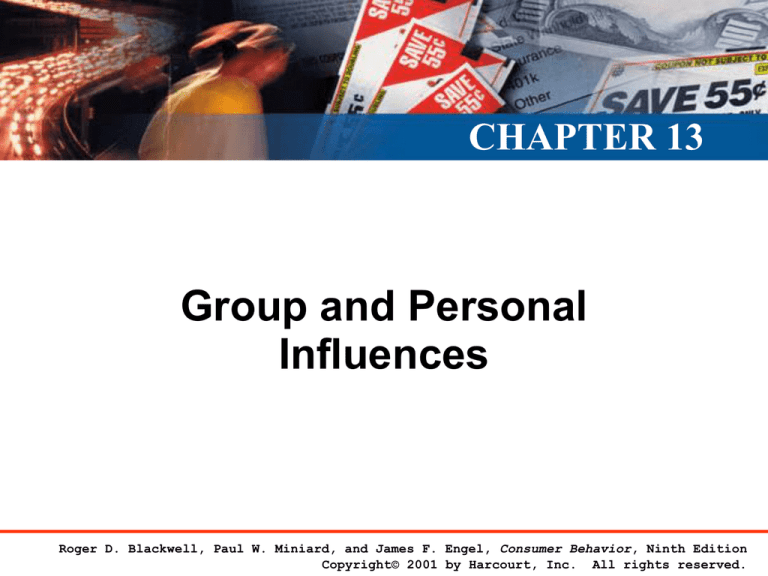
CHAPTER 13
Group and Personal
Influences
Roger D. Blackwell, Paul W. Miniard, and James F. Engel, Consumer Behavior, Ninth Edition
Copyright© 2001 by Harcourt, Inc. All rights reserved.
Group and Personal Influences
on Individuals
Blackwell, Miniard, and Engel, Consumer Behavior, Ninth Edition, Copyright© 2001 by Harcourt, Inc.
All rights reserved.
Personal and Group Influence on
Individuals
Personal
and Group
Influences
on
Individuals
Types of
Influence
Transmission
of Influence
High Degree
of Influence
Individual
Lifestyles,
Behaviors,
Purchases,
and
Consumption
Low Degree
of Influence
Personal and Group Influence on
Individuals
Personal
and Group
Influences
on
Individuals
Group and Personal Influences
on Individuals
Reference group: any person or
group of people that significantly
influences an individual’s behavior
May be individuals (celebrities,
athletes, or political leaders) or
groups of individuals with
similarities (musical groups or
sports teams)
Blackwell, Miniard, and Engel, Consumer Behavior, Ninth Edition, Copyright© 2001 by Harcourt, Inc.
All rights reserved.
Types of Reference Groups
Primary: a social aggregation that
is sufficiently intimate to permit
and facilitate unrestricted face-toface interaction (ex: family)
Secondary: groups in which faceto-face interaction occurs, but it is
more sporadic, less comprehensive, and less influential in
shaping thought and behavior (ex:
professional associations or
community organizations)
Blackwell, Miniard, and Engel, Consumer Behavior, Ninth Edition, Copyright© 2001 by Harcourt, Inc.
All rights reserved.
Types of Reference Groups
Formal: groups characterized by a
defined structure (often written)
and a known list of members and
requirements for membership
Informal: have less structure than
formal groups and are likely to be
based on friendship or interests
Blackwell, Miniard, and Engel, Consumer Behavior, Ninth Edition, Copyright© 2001 by Harcourt, Inc.
All rights reserved.
Types of Reference Groups
Membership: when individuals are
recognized as members of a group,
they have achieved formal
acceptance status in the group
Aspirational: groups that exhibit a
desire to adopt the norms, values,
and behaviors of others with whom
the individuals aspire to associate
Blackwell, Miniard, and Engel, Consumer Behavior, Ninth Edition, Copyright© 2001 by Harcourt, Inc.
All rights reserved.
Types of Reference Groups
Dissociative: groups from which an
individual tries to avoid association
Virtual: groups that are based on
sets of social relations among
people rather than face-to-face
relationships
Blackwell, Miniard, and Engel, Consumer Behavior, Ninth Edition, Copyright© 2001 by Harcourt, Inc.
All rights reserved.
Personal and Group Influence on
Individuals
Personal
and Group
Influences
on
Individuals
Personal and Group Influence on
Individuals
Personal
and Group
Influences
on
Individuals
Types of
Influence
Types of Group Influence
Normative: when individuals alter
their behaviors or beliefs to meet the
expectations of a group
Blackwell, Miniard, and Engel, Consumer Behavior, Ninth Edition, Copyright© 2001 by Harcourt, Inc.
All rights reserved.
Types of Group Influence
Normative: when individuals alter
their behaviors or beliefs to meet the
expectations of a group
Value-expressive: when a need for
psychological association with a
group causes acceptance of its
norms, values, attitudes, or behaviors
Blackwell, Miniard, and Engel, Consumer Behavior, Ninth Edition, Copyright© 2001 by Harcourt, Inc.
All rights reserved.
Types of Group Influence
Normative: when individuals alter
their behaviors or beliefs to meet the
expectations of a group
Value-expressive: when a need for
psychological association with a
group causes acceptance of its
norms, values, attitudes, or behaviors
Informational: when people have
difficulty assessing product or brand
characteristics by their own contacts
or observations
Blackwell, Miniard, and Engel, Consumer Behavior, Ninth Edition, Copyright© 2001 by Harcourt, Inc.
All rights reserved.
Personal and Group Influence on
Individuals
Personal
and Group
Influences
on
Individuals
Types of
Influence
Personal and Group Influence on
Individuals
Personal
and Group
Influences
on
Individuals
Types of
Influence
Transmission
of Influence
Personal and Group Influence on
Individuals
Personal
and Group
Influences
on
Individuals
Types of
Influence
Transmission
of Influence
High Degree
of Influence
Individual
Lifestyles,
Behaviors,
Purchases,
and
Consumption
Low Degree
of Influence
How Reference Groups Influence
Individuals
Blackwell, Miniard, and Engel, Consumer Behavior, Ninth Edition, Copyright© 2001 by Harcourt, Inc.
All rights reserved.
How Reference Groups Influence
Individuals
Socialization: permits an individual
to know what behavior is likely to
result in stability both for the
individual and for the group
Manual may tell people how to
dress in the workplace
Informal groups may tell them
what is acceptable and the norm in
that particular environment
Blackwell, Miniard, and Engel, Consumer Behavior, Ninth Edition, Copyright© 2001 by Harcourt, Inc.
All rights reserved.
How Reference Groups Influence
Individuals
Self-concept: people protect and
modify their self-concept in their
interactions with group members
People can maintain self-concept
by conforming to learned roles
Testimonial advertising is effective
when the self projected in the ad is
consistent with the idealized self of
the target consumer
Blackwell, Miniard, and Engel, Consumer Behavior, Ninth Edition, Copyright© 2001 by Harcourt, Inc.
All rights reserved.
How Reference Groups Influence
Individuals
Social comparison: individuals
often assess themselves by
comparing themselves to others
Consumers often use reference
groups as benchmarks to measure
their own behaviors, opinions,
abilities, and possessions
Advertising or television can be
sources of social comparison
Blackwell, Miniard, and Engel, Consumer Behavior, Ninth Edition, Copyright© 2001 by Harcourt, Inc.
All rights reserved.
How Reference Groups Influence
Individuals
Conformity: a change in beliefs or
actions based on real or perceived
group pressures
Compliance: when an individual
conforms to the wishes of the group
without accepting all its beliefs or
behaviors
Acceptance: when an individual
actually changes his or her beliefs
and values to those of the group
Blackwell, Miniard, and Engel, Consumer Behavior, Ninth Edition, Copyright© 2001 by Harcourt, Inc.
All rights reserved.
How Reference Groups Influence
Individuals
Factors affecting how likely people
are to conform to group norms:
Blackwell, Miniard, and Engel, Consumer Behavior, Ninth Edition, Copyright© 2001 by Harcourt, Inc.
All rights reserved.
How Reference Groups Influence
Individuals
Factors affecting how likely people
are to conform to group norms:
Cohesiveness of group
Size of group
Group’s expertise on topic
Person’s desire to belong
Individual’s need for social acceptance
Public versus private use of product
Blackwell, Miniard, and Engel, Consumer Behavior, Ninth Edition, Copyright© 2001 by Harcourt, Inc.
All rights reserved.
Reference Group Influence on Product and Brand
Purchase Decisions
PRODUCT
Weak Reference Group
Influences
Strong Reference Group
Influences
PUBLIC NECESSITIES
PUBLIC LUXURIES
Influence: Weak
product & strong brand
Influence: Strong
product & strong brand
(watch, autos, suits)
(golf clubs, skis, boat)
PRIVATE NECESSITIES
PRIVATE LUXURIES
Influence: Weak
product & weak brand
Influence: Strong
product & weak brand
(mattress, refrigerator)
(icemaker)
Source: William O. Bearden and Michael J. Etzel, “Reference Group Influences on Product and Brand
Purchase Decisions,” Journal of Consumer Research, 9 (September 1982), 1985.
Normative Influence in Marketing
Strategy
Normative compliance is declining in its
impact as many consumers put
individual needs ahead of group needs
Extended families have less face-to-face
contact and people are more socially
isolated than in the past
Television and mass media expand
people’s horizons beyond social circles
Some consumers want to express
individuality more than group affiliation
Blackwell, Miniard, and Engel, Consumer Behavior, Ninth Edition, Copyright© 2001 by Harcourt, Inc.
All rights reserved.
Celebrity and Other Reference
Group Appeals in Advertising
Testimonials: celebrities tout
products based on personal usage
Blackwell, Miniard, and Engel, Consumer Behavior, Ninth Edition, Copyright© 2001 by Harcourt, Inc.
All rights reserved.
Linda Evans,
a television
star famous
for her role as
Crystal
Karrington on
Dynasty
(Denver
Clan), touts a
facial toning
mask.
Blackwell, Miniard, and Engel, Consumer Behavior, Ninth Edition, Copyright© 2001 by Harcourt, Inc.
All rights reserved.
Celebrity and Other Reference
Group Appeals in Advertising
Testimonials: celebrities tout
products based on personal usage
Endorsements: celebrities lend
their name or likeness to a product
without necessarily being an
expert in the area
Blackwell, Miniard, and Engel, Consumer Behavior, Ninth Edition, Copyright© 2001 by Harcourt, Inc.
All rights reserved.
Pierce Brosnan endorses Omega watches, as
does his film character James Bond.
Celebrity and Other Reference
Group Appeals in Advertising
Testimonials: celebrities tout
products based on personal usage
Endorsements: celebrities lend
their name or likeness to a product
without necessarily being an
expert in the area
Spokesperson: someone who
represents a brand or company for
an extended period of time
Blackwell, Miniard, and Engel, Consumer Behavior, Ninth Edition, Copyright© 2001 by Harcourt, Inc.
All rights reserved.
Celebrity and Other Reference
Group Appeals in Advertising
Expert appeal: appeal from a
person possessing unique
information or skills that can help
consumers make better purchase
decisions than other types of
spokespersons
Common-man appeal: testimonials
from “regular” consumers with
whom most consumers can relate
Blackwell, Miniard, and Engel, Consumer Behavior, Ninth Edition, Copyright© 2001 by Harcourt, Inc.
All rights reserved.
Transmission of Influence
Through Dyadic Exchanges
Blackwell, Miniard, and Engel, Consumer Behavior, Ninth Edition, Copyright© 2001 by Harcourt, Inc.
All rights reserved.
Transmission of Influence
Through Dyadic Exchanges
Person-to-person exchange in
which an individual receives
personal communication from
someone about behaviors or
opinions) and then receives
feedback on their own behaviors
Dyadic exchange requires the
exchange of resources (comments
and opinions)
Blackwell, Miniard, and Engel, Consumer Behavior, Ninth Edition, Copyright© 2001 by Harcourt, Inc.
All rights reserved.
Dyadic Exchanges
Word-of-mouth Communication
Opinion Leadership
Service Encounters
Blackwell, Miniard, and Engel, Consumer Behavior, Ninth Edition, Copyright© 2001 by Harcourt, Inc.
All rights reserved.
Word-of-mouth Communication
Word-of-mouth communication:
informal transmission of ideas,
comments, opinions, and
information between two people,
neither one of which is a marketer
The receiver gains information
about behaviors and choices
The sender increases its confidence
in its product or behavior choice by
persuading others to do the same
Blackwell, Miniard, and Engel, Consumer Behavior, Ninth Edition, Copyright© 2001 by Harcourt, Inc.
All rights reserved.
Benefits of Word-of-Mouth
Hedonic Benefits
Functional Benefits
-decrease risk of new behavior
-increase confidence in choice
-decrease cognitive dissonance
-increase likelihood of
acceptance by a desired group
or individual
-more information about options
-more reliable/credible
information
-less time spent on search
-enhanced relationship with
another individual
-feeling of power and prestige of
influencing others’ behaviors
-enhanced position within a
group
-decreased doubt about one’s
own behavior
-potential reciprocity of exchange
-increased attention and status
-increased number of individuals
with similar behaviors
-increased cohesion within group
-satisfaction of verbal expression
Opinion Leadership
Opinion leadership: the sender of
information is often considered an
opinion leader--a person who
influences the decisions of others
Opinion leaders might be experts in
one area but not in others
The greater the perceived knowledge
of a category, the more likely that
person’s opinions are to influence
others’ decisions
Blackwell, Miniard, and Engel, Consumer Behavior, Ninth Edition, Copyright© 2001 by Harcourt, Inc.
All rights reserved.
Opinion Leadership
Personal influence in the form of opinion
leadership is likely to occur when:
Blackwell, Miniard, and Engel, Consumer Behavior, Ninth Edition, Copyright© 2001 by Harcourt, Inc.
All rights reserved.
Opinion Leadership
Personal influence in the form of opinion
leadership is likely to occur when:
An individual has limited knowledge
A person cannot evaluate options
The consumer does not trust advertising
or other sources of information
Other information sources have low
credibility with the consumer
The individual has a high need for social
approval
Blackwell, Miniard, and Engel, Consumer Behavior, Ninth Edition, Copyright© 2001 by Harcourt, Inc.
All rights reserved.
Opinion Leadership
Strong social ties exist between sender
and receiver
The product is complex
The product is difficult to test against
objective criterion
The product is highly visible to others
Blackwell, Miniard, and Engel, Consumer Behavior, Ninth Edition, Copyright© 2001 by Harcourt, Inc.
All rights reserved.
Opinion Leadership
Market mavens: individuals who
serve as information sources about
the marketplace because of their
awareness of new products and
other marketplace activities
Blackwell, Miniard, and Engel, Consumer Behavior, Ninth Edition, Copyright© 2001 by Harcourt, Inc.
All rights reserved.
Opinion Leadership
Market mavens: individuals who
serve as information sources about
the marketplace because of their
awareness of new products and
other marketplace activities
Surrogate consumers (shoppers):
an individual who acts as an agent
to guide, direct, and or conduct
activities in the marketplace
Blackwell, Miniard, and Engel, Consumer Behavior, Ninth Edition, Copyright© 2001 by Harcourt, Inc.
All rights reserved.
Service Encounters
Service encounters: occurs when
there is personal communication
between a consumer and a marketer
May be a consumption experience
within a store--the various transactions and services that occur
during a purchase
May be an experience with a specific
service a consumer purchases
Blackwell, Miniard, and Engel, Consumer Behavior, Ninth Edition, Copyright© 2001 by Harcourt, Inc.
All rights reserved.
Service Encounters
Service providers must understand
the needs of different customers and
matching the appropriate sales
associate or sales approach to a
particular type of customer
Which customers need a lot of
attention and which ones prefer to
be left alone
Salesperson fosters a relationship
between buyer and seller
Blackwell, Miniard, and Engel, Consumer Behavior, Ninth Edition, Copyright© 2001 by Harcourt, Inc.
All rights reserved.
Transmitting Personal Influences
Blackwell, Miniard, and Engel, Consumer Behavior, Ninth Edition, Copyright© 2001 by Harcourt, Inc.
All rights reserved.
Transmitting Personal Influences
Trickle-down: alleges that lower
classes often emulate the behavior
their higher-class counterparts
Influence is transmitted vertically
through social classes, as higher
classes express wealth through
conspicuous consumption, and lower
classes copy their behavior
Today, trends are transmitted through
mass media and classes do not have
direct contact
Blackwell, Miniard, and Engel, Consumer Behavior, Ninth Edition, Copyright© 2001 by Harcourt, Inc.
All rights reserved.
Transmitting Personal Influences
Two-step Flow
Information
and Influence
Information
Mass
Media
Opinion
Leader
Opinion
Seekers
Blackwell, Miniard, and Engel, Consumer Behavior, Ninth Edition, Copyright© 2001 by Harcourt, Inc.
All rights reserved.
Transmitting Personal Influences
Multistep Flow
Mass
Media
Opinion
Leader
Opinion
Seekers
Gatekeepers
Blackwell, Miniard, and Engel, Consumer Behavior, Ninth Edition, Copyright© 2001 by Harcourt, Inc.
All rights reserved.
WOM and Opinion Leaders in
Advertising and Marketing
Strategy
Blackwell, Miniard, and Engel, Consumer Behavior, Ninth Edition, Copyright© 2001 by Harcourt, Inc.
All rights reserved.
WOM and Opinion Leaders in
Advertising and Marketing
Strategy
Advertising can provide information
to consumers about products they
might seek from other sources and
which may be discussed in WOM
Blackwell, Miniard, and Engel, Consumer Behavior, Ninth Edition, Copyright© 2001 by Harcourt, Inc.
All rights reserved.
As more
consumers are
concerned
about their
health, this ad
provides them
with valuable
information
about the
benefits of soy
protein, which
may be passed
on with WOM.
Blackwell, Miniard, and Engel, Consumer Behavior, Ninth Edition, Copyright© 2001 by Harcourt, Inc.
All rights reserved.
WOM and Opinion Leaders in
Advertising and Marketing
Strategy
Advertising can provide information
to consumers about products they
might seek from other sources and
which may be discussed in WOM
Advertising can create WOM among
consumers and peer groups
Blackwell, Miniard, and Engel, Consumer Behavior, Ninth Edition, Copyright© 2001 by Harcourt, Inc.
All rights reserved.
Internetbased firms
seek to
create WOM
with their
ads, as
hotjobs.com
does with
this ad
written for
Hillary
Clinton.
Blackwell, Miniard, and Engel, Consumer Behavior, Ninth Edition, Copyright© 2001 by Harcourt, Inc.
All rights reserved.
WOM and Opinion Leaders in
Advertising and Marketing
Strategy
Advertising can provide information
to consumers about products they
might seek from other sources and
which may be discussed in WOM
Advertising can create WOM among
consumers and peer groups
Blackwell, Miniard, and Engel, Consumer Behavior, Ninth Edition, Copyright© 2001 by Harcourt, Inc.
All rights reserved.
The Advertising-WOM
Relationship
For some firms, WOM is a substitute
for advertising
Blackwell, Miniard, and Engel, Consumer Behavior, Ninth Edition, Copyright© 2001 by Harcourt, Inc.
All rights reserved.
The Advertising-WOM
Relationship
Victoria’s
Secret built
much of its
brand
awareness
with WOM
generated by
its catalog,
models, and
promotions
Blackwell, Miniard, and Engel, Consumer Behavior, Ninth Edition, Copyright© 2001 by Harcourt, Inc.
All rights reserved.
The Advertising-WOM
Relationship
For some firms, WOM is a substitute
for advertising
Advertising could be targeted to
opinion leaders, although it is
difficult to identify this segment
unless they belong to an identifiable
group
Blackwell, Miniard, and Engel, Consumer Behavior, Ninth Edition, Copyright© 2001 by Harcourt, Inc.
All rights reserved.
The Advertising-WOM
Relationship
Firms may stimulate WOM by giving
away or loaning products to opinion
leaders to use or display
Organizations may hire opinion
leaders to influence consumers
(camera stores may hire
professional photographers to work
in their stores)
Blackwell, Miniard, and Engel, Consumer Behavior, Ninth Edition, Copyright© 2001 by Harcourt, Inc.
All rights reserved.
The Advertising-WOM
Relationship
Firms can create opinion leaders by
providing incentives for new
customers to attract others to the
store
Companies can activate search
through advertising that encourages
consumers to “ask a person who
knows” or “tell a friend”
Blackwell, Miniard, and Engel, Consumer Behavior, Ninth Edition, Copyright© 2001 by Harcourt, Inc.
All rights reserved.
Managing Negative WOM
Monitoring the content of WOM-what consumers are saying about
the product or company
Monitoring rumors which do not
always appear in customer
complaint reports
Creating a strategy to respond to
rumors and negative WOM
Blackwell, Miniard, and Engel, Consumer Behavior, Ninth Edition, Copyright© 2001 by Harcourt, Inc.
All rights reserved.
Diffusion of Innovations
Blackwell, Miniard, and Engel, Consumer Behavior, Ninth Edition, Copyright© 2001 by Harcourt, Inc.
All rights reserved.
Diffusion of Innovations
Innovation: any idea or product
perceived by the potential adopter
to be new
Marketers often use the word
“new” to symbolize an innovation
Innovations may also be usagebased--using an existing product
in a new way
Blackwell, Miniard, and Engel, Consumer Behavior, Ninth Edition, Copyright© 2001 by Harcourt, Inc.
All rights reserved.
Pringles
introduced
a fat-free
potato chip
using the
new fat
substitute
Olean.
Blackwell, Miniard, and Engel, Consumer Behavior, Ninth Edition, Copyright© 2001 by Harcourt, Inc.
All rights reserved.
Types of Innovations
Continuous innovation
Dynamically continuous
innovation
Discontinuous innovation
Blackwell, Miniard, and Engel, Consumer Behavior, Ninth Edition, Copyright© 2001 by Harcourt, Inc.
All rights reserved.
Continuous Innovation
The modification of an existing
product rather than the
establishment of a new product or
product category
Modification may be in the taste,
appearance, performance, or
reliability of the product
Blackwell, Miniard, and Engel, Consumer Behavior, Ninth Edition, Copyright© 2001 by Harcourt, Inc.
All rights reserved.
Crayola
introduced
a new
crayon
which is
washable
and can be
removed
from a
variety of
surfaces.
Blackwell, Miniard, and Engel, Consumer Behavior, Ninth Edition, Copyright© 2001 by Harcourt, Inc.
All rights reserved.
Dynamically Continuous
Innovation
May involve the creation of either a
new product or a significant
alteration of an existing one
Does not generally alter
established purchase or usage
patterns
Blackwell, Miniard, and Engel, Consumer Behavior, Ninth Edition, Copyright© 2001 by Harcourt, Inc.
All rights reserved.
The Kodak
Advantix
system allows
consumers to
take pictures
as they have
in the past;
however, they
have three
picture
formats to
choose from
and they must
use different
film.
Blackwell, Miniard, and Engel, Consumer Behavior, Ninth Edition, Copyright© 2001 by Harcourt, Inc.
All rights reserved.
Discontinuous Innovation
Involves the introduction of an
entirely new product that
significantly alters consumers’
behavior patterns and lifestyles
Examples include television,
automobiles, and computers
Blackwell, Miniard, and Engel, Consumer Behavior, Ninth Edition, Copyright© 2001 by Harcourt, Inc.
All rights reserved.
Evaluating Innovation
Blackwell, Miniard, and Engel, Consumer Behavior, Ninth Edition, Copyright© 2001 by Harcourt, Inc.
All rights reserved.
Evaluating Innovation
Relative Advantage
Compatibility
Complexity
Trialability
Observability
Blackwell, Miniard, and Engel, Consumer Behavior, Ninth Edition, Copyright© 2001 by Harcourt, Inc.
All rights reserved.
Relative Advantage
The degree to which consumers
may perceive the innovation to
offer substantially greater benefits
than the product currently used
Blackwell, Miniard, and Engel, Consumer Behavior, Ninth Edition, Copyright© 2001 by Harcourt, Inc.
All rights reserved.
Relative Advantage
The degree to which consumers
may perceive the innovation to
offer substantially greater benefits
than the product currently used
Relative advantages are often
featured in communication pieces,
advertising, and packaging of
products once in the marketplace
Advantages over old technology
become touted product features
Blackwell, Miniard, and Engel, Consumer Behavior, Ninth Edition, Copyright© 2001 by Harcourt, Inc.
All rights reserved.
Compatibility
The degree to which a new product
is consistent with an individual’s
existing practices, values, needs,
and past experiences of the
potential adopter
Blackwell, Miniard, and Engel, Consumer Behavior, Ninth Edition, Copyright© 2001 by Harcourt, Inc.
All rights reserved.
Compatibility
The degree to which a new product
is consistent with an individual’s
existing practices, values, needs,
and past experiences of the
potential adopter
How does the innovation blend with
products consumers might own?
Will it replace other products or will it
become a part of an existing system?
How does the innovation fit current
purchase or consumption behaviors?
Blackwell, Miniard, and Engel, Consumer Behavior, Ninth Edition, Copyright© 2001 by Harcourt, Inc.
All rights reserved.
Complexity
The degree to which an innovation
is perceived as difficult to
understand and use
The more complex, the more
difficult it may be to be accepted
Complexity is a deterrent of trying
new technology
Blackwell, Miniard, and Engel, Consumer Behavior, Ninth Edition, Copyright© 2001 by Harcourt, Inc.
All rights reserved.
Complexity
How difficult is the innovation to
understand?
How easy is it to explain to consumers
in written form and oral communication?
How frustrating will it be to consumers
when evaluating products or learning
how to use new innovation?
How much time will consumers have to
devote to learning how to use and care
for the product?
Blackwell, Miniard, and Engel, Consumer Behavior, Ninth Edition, Copyright© 2001 by Harcourt, Inc.
All rights reserved.
Trialability
New products are more likely to be
accepted if experimenting or using
the product is made easy
Blackwell, Miniard, and Engel, Consumer Behavior, Ninth Edition, Copyright© 2001 by Harcourt, Inc.
All rights reserved.
Trialability
New products are more likely to be
accepted if experimenting or using
the product is made easy
How easy will it be for people to try the
new product without buying it?
How can a company encourage
consumers to try a new product?
Where will consumers be able to try
the innovation and how will they
receive answers to their questions?
Blackwell, Miniard, and Engel, Consumer Behavior, Ninth Edition, Copyright© 2001 by Harcourt, Inc.
All rights reserved.
Observability
The degree to which results from
using a new product are visible to
friends and neighbors
If consumers can see others using
a new product, that innovation is
likely to diffuse faster than if the
product were used privately
Blackwell, Miniard, and Engel, Consumer Behavior, Ninth Edition, Copyright© 2001 by Harcourt, Inc.
All rights reserved.
The Diffusion Process
Blackwell, Miniard, and Engel, Consumer Behavior, Ninth Edition, Copyright© 2001 by Harcourt, Inc.
All rights reserved.
The Diffusion Process
Diffusion: the process by which
an innovation is communicated
through certain channels over
time among the members of a
social system
Blackwell, Miniard, and Engel, Consumer Behavior, Ninth Edition, Copyright© 2001 by Harcourt, Inc.
All rights reserved.
The Diffusion Process
Diffusion: the process by which
an innovation is communicated
through certain channels over
time among the members of a
social system
Includes:
Diffusion of information and
communication
Consumer decision process
Diffusion or demise of innovation
Blackwell, Miniard, and Engel, Consumer Behavior, Ninth Edition, Copyright© 2001 by Harcourt, Inc.
All rights reserved.
The Diffusion Process
Diffusion of
Innovation
Accept
Organization
Influencer
C
o
n
s
u
m
e
r
(X number of people)
Reject
Diffusion of Information
and Communication
Consumer decision process
Demise
of
Innovation
Factors Affecting Diffusion
Communication (how consumers
learn about innovation)
Time (how long it takes for a
person to move from product
awareness to purchase or
rejection)
Social system (the groups or
segments to which individuals
belong)
Blackwell, Miniard, and Engel, Consumer Behavior, Ninth Edition, Copyright© 2001 by Harcourt, Inc.
All rights reserved.
Speed of Diffusion
Diffusion will be faster if:
Blackwell, Miniard, and Engel, Consumer Behavior, Ninth Edition, Copyright© 2001 by Harcourt, Inc.
All rights reserved.
Speed of Diffusion
Diffusion will be faster if:
Supplier is intensely competitive
Supplier’s reputation is good
Standardized technology is used
Vertical coordination among
channel members exists
Resource commitments are
significant
Blackwell, Miniard, and Engel, Consumer Behavior, Ninth Edition, Copyright© 2001 by Harcourt, Inc.
All rights reserved.
Consumer Decision Process for
Innovations
Blackwell, Miniard, and Engel, Consumer Behavior, Ninth Edition, Copyright© 2001 by Harcourt, Inc.
All rights reserved.
Rogers Model of Innovation Decision Process
Knowledge
Characteristics of the
Decision Making Unit
Rogers Model of Innovation Decision Process
Knowledge Persuasion
Perceived Characteristics
of the Innovation
Rogers Model of Innovation Decision Process
Knowledge Persuasion Decision
Adoption
Continued
adoption
Later adoption
Discontinuance
Rejection
Continued
Rejection
Rogers Model of Innovation Decision Process
Knowledge Persuasion Decision Implementation
Rogers Model of Innovation Decision Process
Knowledge Persuasion Decision Implementation
Confirmation
Rogers Model of Innovation Decision Process
Communication Channels
Knowledge Persuasion Decision Implementation
Confirmation
Source: Everett M. Rogers, Diffusion of Innovation, 3rd Edition (New York; The Free Press, 1983), 165.
Consumer Most Likely to Buy
New Products
Blackwell, Miniard, and Engel, Consumer Behavior, Ninth Edition, Copyright© 2001 by Harcourt, Inc.
All rights reserved.
Adopter Classes
A
B
C
D
E
A= Innovators (2.5%)
B= Early Adopters (13.5%)
C= Early Majority (34%)
D= Late Majority (34%)
E= Laggards (16%)
Blackwell, Miniard, and Engel, Consumer Behavior, Ninth Edition, Copyright© 2001 by Harcourt, Inc.
All rights reserved.
Consumers Likely to Buy New
Products
Innovativeness: the degree to
which an individual adopts an
innovation earlier than other
members of a social system
Cognitive innovators: have a strong
preference for new sensory experiences
Sensory innovators: have a strong
preference for new sensory experiences
Advertising can be targeted to various
types of innovators
Blackwell, Miniard, and Engel, Consumer Behavior, Ninth Edition, Copyright© 2001 by Harcourt, Inc.
All rights reserved.
Managerial Perspectives on
Adoption and Diffusion of
Innovations
Blackwell, Miniard, and Engel, Consumer Behavior, Ninth Edition, Copyright© 2001 by Harcourt, Inc.
All rights reserved.
Managerial Perspectives on
Adoption and Diffusion of
Innovations
Most firms develop new products to fuel
long-term growth and profitability
Consumer insight helps create products
that consumers are likely to adopt
Intuition and information (often gained
from consumers through research)
contribute to the formation of an insight
Insights drive the creation of a new or
adaptation of an existing product
Blackwell, Miniard, and Engel, Consumer Behavior, Ninth Edition, Copyright© 2001 by Harcourt, Inc.
All rights reserved.
V8 introduces
new
packaging,
which is
shelf-stable
and comes in
individual
serving sizes.
It appeals to
consumers’
desire to
drink “on-thego.”
Blackwell, Miniard, and Engel, Consumer Behavior, Ninth Edition, Copyright© 2001 by Harcourt, Inc.
All rights reserved.
Consumer Behavior
Roger D. Blackwell
Paul W. Miniard
James F. Engel
Requests for permission to make copies of any part of the work should be
mailed to the following address:
Permissions Department, Harcourt, Inc.
6277 Sea Harbor Drive
Orlando, Florida 32887-6777
Copyright© 2001 by Harcourt, Inc. All rights reserved.



